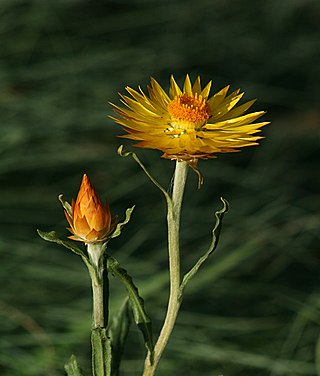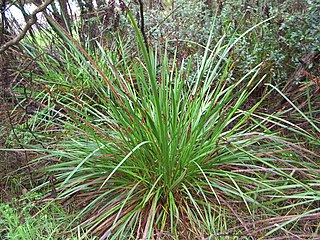
Phyllanthus is the largest genus in the plant family Phyllanthaceae. Estimates of the number of species in this genus vary widely, from 750 to 1200. Phyllanthus has a remarkable diversity of growth forms including annual and perennial herbs, shrubs, climbers, floating aquatics, and pachycaulous succulents. Some have flattened leaflike stems called cladodes. It has a wide variety of floral morphologies and chromosome numbers and has one of the widest range of pollen types of any seed plant genus.

Phyllanthaceae is a family of flowering plants in the eudicot order Malpighiales. It is most closely related to the family Picrodendraceae.

Panicoideae is the second-largest subfamily of the grasses with over 3,500 species, mainly distributed in warm temperate and tropical regions. It comprises some important agricultural crops, including sugarcane, maize, sorghum, and switchgrass.

Xerochrysum is a genus of flowering plants native to Australia. It was defined by Russian botanist Nikolai Tzvelev in 1990, preceding Bracteantha which was described the following year.

Lepidosperma is a genus of flowering plant of the family Cyperaceae. Most of the species are endemic to Australia, with others native to southern China, southeast Asia, New Guinea, New Caledonia and New Zealand.

Schoenus is a predominately austral genus of sedges, commonly known as bogrushes, or veldrushes in South Africa. Species of this genus occur mainly in South Africa, Australia and Southeast Asia. Others are found in scattered locations worldwide, from Europe to Asia, North Africa and the Americas. Three species occur in the peatlands of southern South America, including S. antarcticus which is found in Tierra del Fuego, where it forms a component of hyperhumid Magellanic moorland.

John Beaumont Williams was an Australian botanist who spent most of his working life, from 1957 until 1992 as a lecturer in taxonomy, anatomy and ecology at the University of New England. He graduated Bachelor of Science from Sydney University in 1953 and commenced a PhD under the supervision of Noel Beadle. When Beadle was appointed Chair of Botany at the University of New England, Williams followed to take up a lecturing position at the same institution and to complete his PhD. For the next few years he concentrated on teaching, fieldwork and producing plant lists for north-eastern New South Wales as well as spending time studying in the Jodrell Laboratory at Royal Botanic Gardens, Kew working on the family Haemodoraceae.

Noel Charles William Beadle was an Australian botanist and plant ecologist who spent most of his working life at the University of New England in Armidale.
Cyperus latzii is a sedge of the family Cyperaceae that is native to Australia, and found in the Northern Territory and Western Australia.
Karen Louise Wilson is an Australian botanist.

Lepidosperma leptostachyum is a species of flowering plant in the sedge family, Cyperaceae, a native of Southwest Australia.

Phyllanthus calycinus, known as false boronia and snowdrop spurge, is a small shrub in the family Phyllanthaceae, which grows to heights from 20 cm to 1.2 m, often on sandy soils. It is found in both Western Australia and South Australia. In Western Australia its white-cream to pink flowers may be seen from June to January, and in South Australia, from May to October.
Joy Thompson was an Australian botanist. Her main research areas were taxonomy and Myrtaceae.
Russell Lindsay Barrett is an Australian botanist.
Paul Graham Wilson was an Australian botanist. As of 1998, Wilson was the most prolific contributor to the journal Nuytsia, contributing to the first issue in 1970 and to the 12th volume in 1998, which was dedicated to him for his contributions to plant taxonomy and to celebrate his 70th birthday. Since his retirement from the Western Australian Herbarium in 1993, he has helped to maintain a comprehensive census of the flora of Western Australia.

Phebalium verrucosum is a species of shrub that is endemic to New South Wales. It has branchlets densely covered with white scales, narrow elliptic, oblong or linear leaves covered with white scales on the lower side, and umbels of creamy white flowers with silvery or rust-coloured scales on the back of the petals.
Kelly Anne Shepherd is an Australian botanist, who has published some 91 names.
Walwhalleya is a genus of flowering plants belonging to the family Poaceae. All members use C3 photosynthesis

Anthelepis is a genus of flowering plants belonging to the family Cyperaceae, and was first described in 2019 by the Australian botanists, Russell Barrett, Karen Wilson and Jeremy Bruhl.
Anthelepis guillauminii is a plant in the Cyperaceae family, first described in 1938 by Georg Kükenthal as Schoenus guillauminii, with the current name being given in 2019 as belonging to the new genus, Anthelepis by Russell Barrett, Karen Wilson and Jeremy Bruhl. The species is native to New Caledonia.











